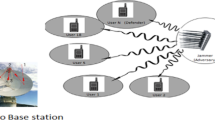Abstract
Cognitive Radio Networks have been proposed as a promising solution for the spectrum deficiency problem. Even though, because of the opportunistic access and heterogeneity nature of these networks, they are exposed to threats such as the presence of jammer which aims to jeopardize the network transmissions. In this article, we introduce an anti-jamming cooperative framework to mitigate or minimize the impact of the jammer on the cognitive radio network. In the proposed solution, the secondary coordinator distributes the Secondary Users (SU) over the selected channel and pairs the SUs to form cooperative coalitions which utilize cooperative transmission to establish more robust transmission links to overcome the effect of the jammer power. Stackelberg game is used to model the interaction between the jammer and the network coordinator. The outcomes show the superiority of using cooperative transmission over the traditional direct transmission. Also, the performance of the secondary network enhances as the number of SUs increases due to the higher probability of forming cooperative groups.
Access this chapter
Tax calculation will be finalised at checkout
Purchases are for personal use only
Similar content being viewed by others
Notes
- 1.
As an example, in Fig. 2, it is supposed that the jammer is able to divide its total power to 10 levels each equals to 10% of the total power and the jammer inject 4 levels in channel 1 (40% of its power) and 6 levels in channel 2 (the remaining 60%).
References
Haykin, S.: Cognitive radio: brain-empowered wireless communications. IEEE J. Sel. Areas Commun. 23(2), 201–220 (2005)
Bhattacharjee, S., Rajkumari, R., Marchang, N.: Cognitive radio networks security threats and attacks: a review. J. Comput. Appl. ICICT 975, 8887 (2014)
Yu, Y., Hu, L., Li, H., Zhang, Y., Wu, F., Chu, J.: The security of physical layer in cognitive radio. J. Commun. Netw. 9(12), 28–33 (2014)
Ganesh, D., Pavan Kumar, T.: A survey on advances in security threats and its countermeasures in cognitive radio networks. Int. J. Eng. Technol. 7, 372–378 (2018)
Cadeau, W., Li, X.: Anti-jamming performance of cognitive radio networks under multiple uncoordinated jammers in fading environment. In: Proceedings of the 46th Annual Conference on Information Sciences and Systems (CISS), March 2012
Chen, C., Song, M., Xin, C., Backens, J.: A game-theoretical anti-jamming scheme for cognitive radio networks. IEEE Network 27(3), 22–27 (2013)
Xiao, L., Liu, J., Li, Y., Mandayam, N., Poor, H.V.: Prospect theoretic analysis of anti-jamming communications in cognitive radio networks. In: Proceedings of the IEEE Global Communication Conference (Globecom), pp. 1–6 (2014)
Yang, D., Xue, G., Zhang, J., Richa, A., Fang, X.: Coping with a smart jammer in wireless networks: a Stackelberg game approach. IEEE Trans. Wireless Commun. 12(8), 4038–4047 (2013)
Chang, G., Wang, S., Liu, Y.: A jamming-resistant channel hopping scheme for cognitive radio networks. IEEE Trans. Wireless Commun. 16(10), 6712–6725 (2017)
Li, Y., Xiao, L., Liu, J., Tang, Y.: Power control Stackelberg game in cooperative anti-jamming communications. In: Proceedings of the 5th International Conference on Game Theory Network, Beijing, China, November 2014
Xiao, L., Chen, T., Liu, J., Dai, H.: Anti-jamming transmission Stackelberg game with observation errors. IEEE Commun. Lett. 19(6), 949–952 (2015)
Jia, L., Xu, Y., Feng, S., Anpalagan, A.: Stackelberg game approaches for anti-jamming defence in wireless networks. IEEE Wireless Commun. 25(6), 120–128 (2018)
Jia, L., Yao, F., Sun, Y., et al.: A hierarchical learning solution for anti-jamming Stackelberg game with discrete power strategies. IEEE Wireless Commun. Lett. 6(6), 818–821 (2017)
Jia, L., Yao, F., Sun, Y., et al.: Bayesian Stackelberg game for anti-jamming with incomplete information. IEEE Commun. Lett. 20(10), 1991–1994 (2016)
Liu, P., Tao, Z., Narayanan, S., Korakis, T., Panwar, S.S.: CoopMAC: a cooperative MAC for wireless LANs. IEEE J. Sel. Areas Commun. 25(2), 340–354 (2007)
Zhu, H., Dusit, N., Saad, W., Tamer, B., Are, H.: Game Theory in Wireless and Communication Networks: Theory, Models, and Applications. Cambridge University Press, Cambridge (2012)
Author information
Authors and Affiliations
Corresponding author
Editor information
Editors and Affiliations
Rights and permissions
Copyright information
© 2020 Springer Nature Switzerland AG
About this paper
Cite this paper
Al-Hashmy, R.M., AbdelRaheem, M., Mohmed, U.S. (2020). Anti-jamming Cooperative Technique for Cognitive Radio Networks: A Stackelberg Game Approach. In: Hassanien, A., Shaalan, K., Tolba, M. (eds) Proceedings of the International Conference on Advanced Intelligent Systems and Informatics 2019. AISI 2019. Advances in Intelligent Systems and Computing, vol 1058. Springer, Cham. https://doi.org/10.1007/978-3-030-31129-2_68
Download citation
DOI: https://doi.org/10.1007/978-3-030-31129-2_68
Published:
Publisher Name: Springer, Cham
Print ISBN: 978-3-030-31128-5
Online ISBN: 978-3-030-31129-2
eBook Packages: Intelligent Technologies and RoboticsIntelligent Technologies and Robotics (R0)




